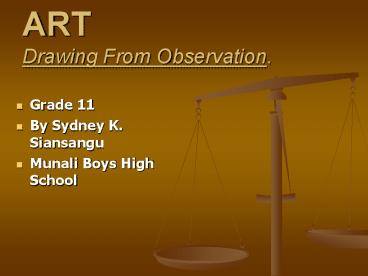ART Drawing From Observation. - PowerPoint PPT Presentation
1 / 7
Title:
ART Drawing From Observation.
Description:
Make a careful study of the object to be drawn to know exactly how to capture it ... seeds, seed shells, veins on the back of a leaf may need a magnifying glass. ... – PowerPoint PPT presentation
Number of Views:1024
Avg rating:3.0/5.0
Title: ART Drawing From Observation.
1
ARTDrawing From Observation.
- Grade 11
- By Sydney K. Siansangu
- Munali Boys High School
2
Definition
- Observation drawing refers to making a detailed
drawing of any object which can either be
artificial or natural. - Note that besides achieving form, visual elements
such as texture on the given object must be
highlighted.
3
Points to Note When Dealing With Observational
Drawing
- Make a careful study of the object to be drawn to
know exactly how to capture it ie the best
angle/view. - Note that the object to be drawn must as close as
possible because certain objects either
artificial or natural may be difficult to capture
by the eye if far from the artist. - Certain tiny objects like insects, seeds, seed
shells, veins on the back of a leaf may need a
magnifying glass . - Textural effects need to be highlighted on a
given object
4
Additional Points
- Light
- Objects such as a shelled cob of maize, a shoe,
the bark of a tree and other objects that need
detail can be a meter or so away from the artist
to maximise the viewing of all the details on a
given object. - When starting to draw, capture only what you are
able to see and not imagine what you think should
be there. - Remember the source of light is important to know
where the shadow should fall. - The shadow falls on the opposite side of the
source of light.
Cast
Shadow
source of light
Drawing showing the cast shadow underneath The
heel.
5
Composition
- All objects to be drawn must be evenly
distributed on the working surface paper - Always centre the objects drawn
- Maximise working surface
- Proportion on all the objects is very important
ie the relationship in terms of size for the
objects drawn
6
Overlapping Objects
- Overlapping perspective for objects displayed
closely together must be highlighted by having
darker tones in between the objects drawn and
then killing the dark tone until it meets the
light. - Overlapping perspective refers to the partial
obstruction of the objects closely displayed
together
7
Shading
- The ultimate purpose of shading is to achieve
form - Form is the solid feel of roundness of an object
a two dimensional effect in pictorial Art - Note that basic elements of design such as line
will assist in achieving the textural effect when
using hatching or cross hatching - Always create a base on any drawing made































